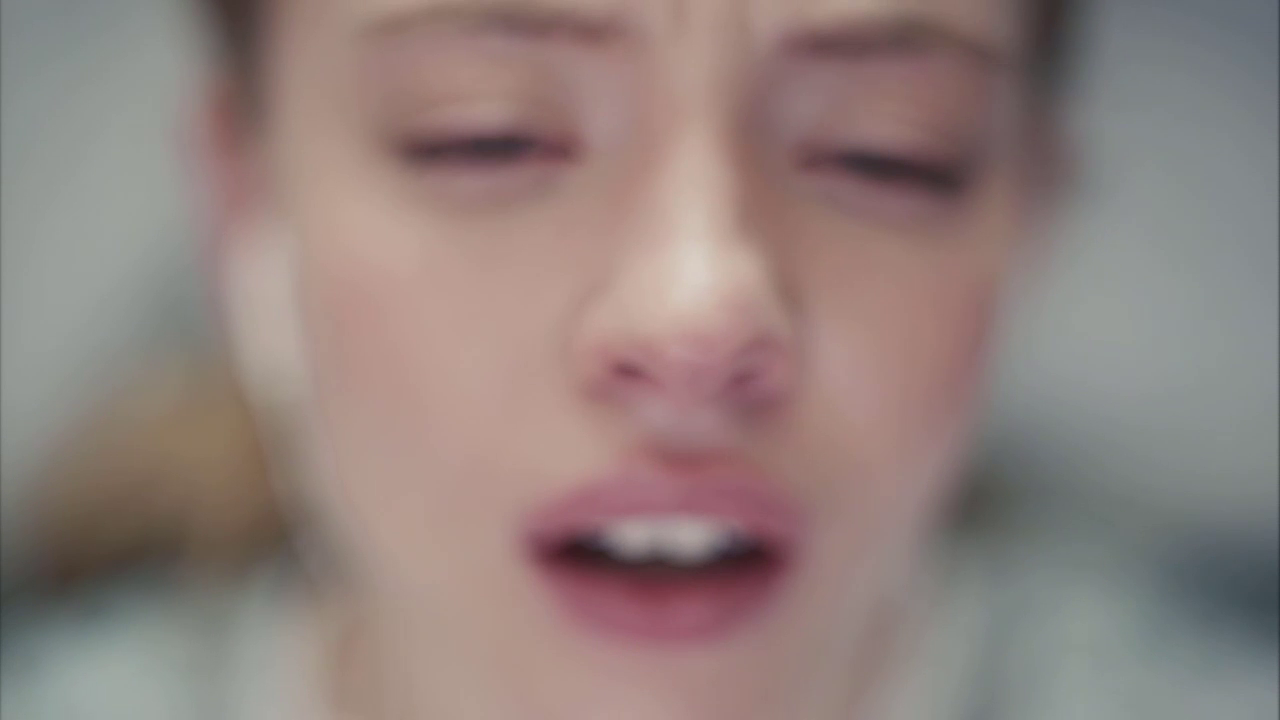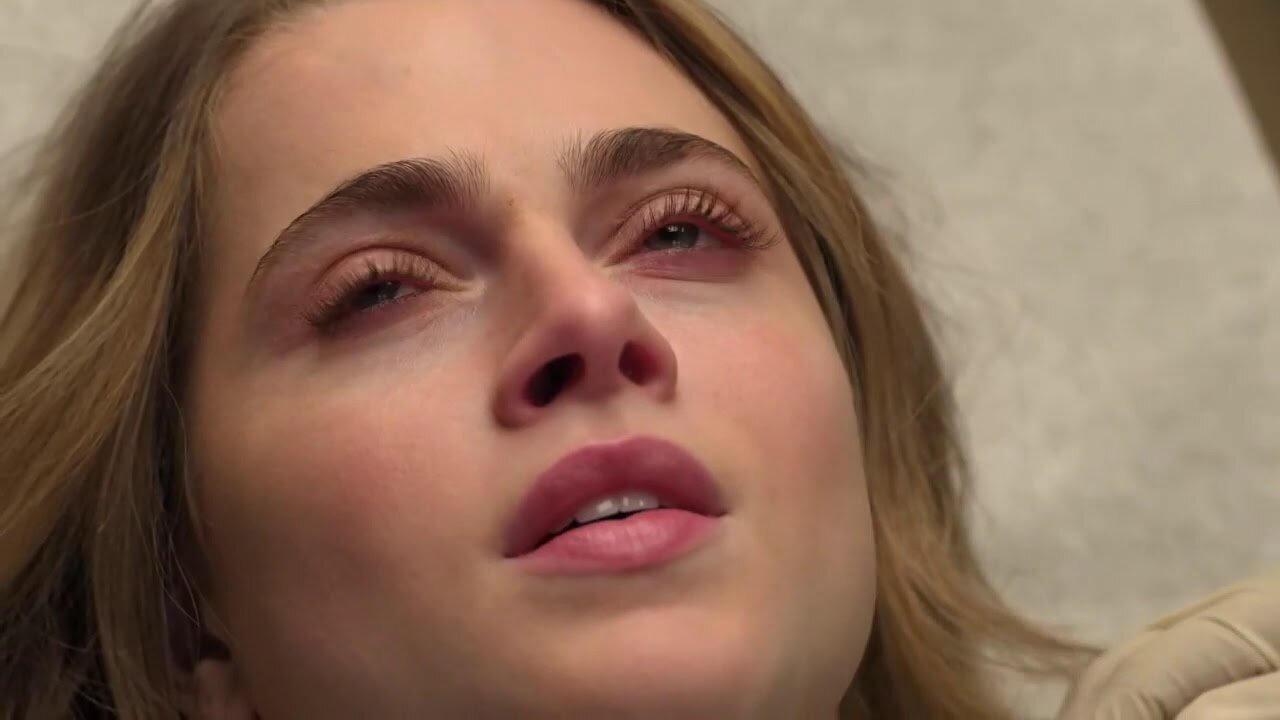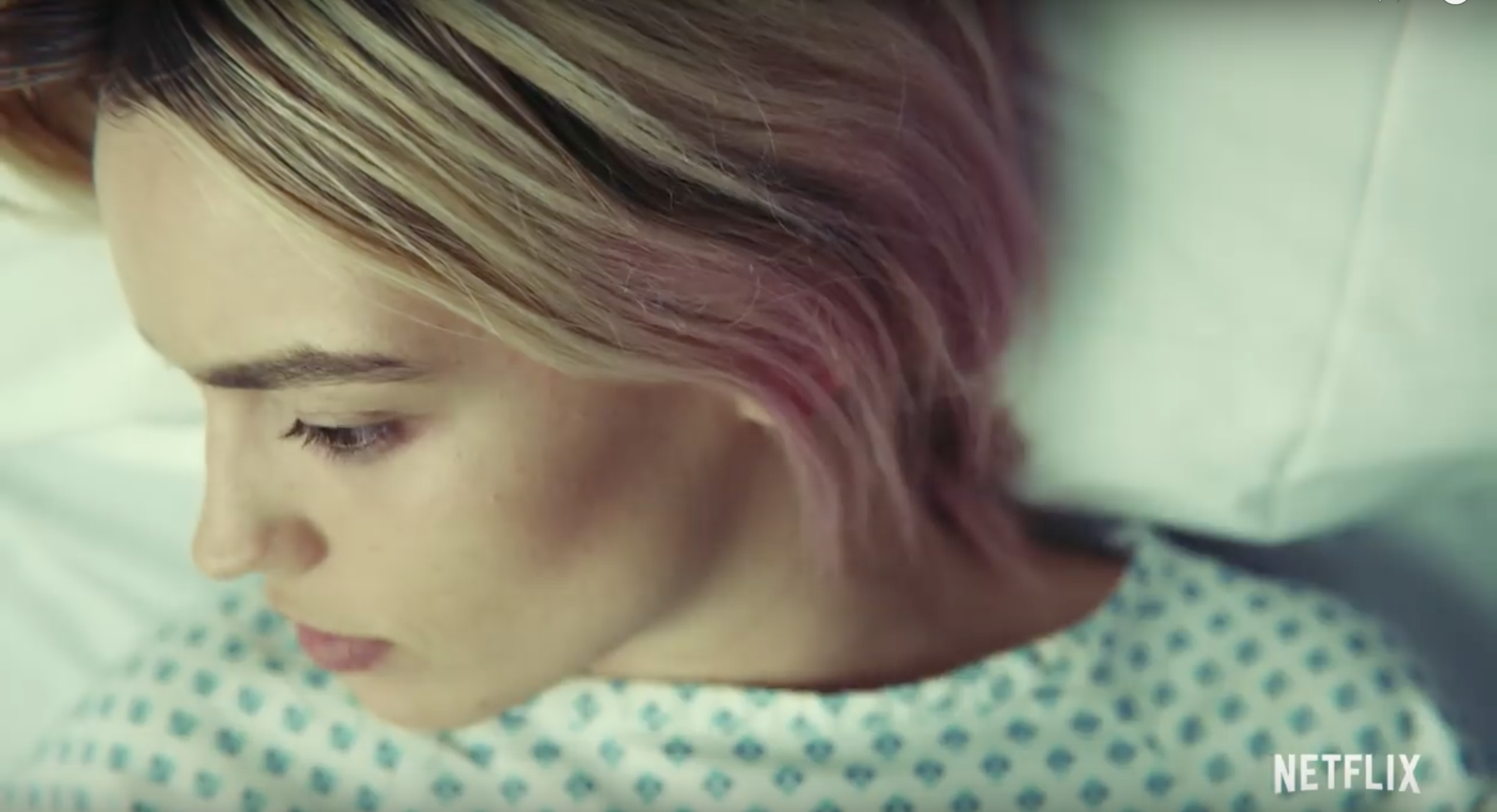BY DR TANYA HORECK, READER IN FILM, MEDIA AND CULTURE (ANGLIA RUSKIN UNIVERSITY) AND School of Sexuality Education ADVISOR.
Chloe and Zach at the abortion clinic, 13 Reasons Why (Netflix, 2017-).
In Amy Heckerling’s 1982 directorial debut, Fast Times at Ridgemont High, 15-year-old Stacy Hamilton (Jennifer Jason Leigh) gets pregnant after casual (and quite inadequate) sex with Mike Damone (Robert Romanus). Stacy is pragmatic about dealing with the pregnancy and asks Damone to share the costs of an abortion with her. But he fails to help or to even accompany her to the clinic, and it is ultimately her older brother, Brad (Judge Reinhold) who drives her there and brings her home. What stands out now, re-watching this Gen X classic in 2020, is the conversation between Stacy and her worldly wise best friend Linda (Phoebe Cates) after the abortion. Linda, who is outraged over Mike’s dereliction of duty, offers to have it out with him. The ever-rational Stacy tells her: ‘Look, don’t do anything. I don’t even like the guy.’ Linda angrily retorts: ‘He’s not a guy, he’s a little prick’. Cue the following sequence, played to the jaunty soundtrack of the Go Gos ‘Speeding,’ in which a downcast Ramone finds his car and locker vandalized with ‘prick’ and ‘little prick’ respectively. In that scene, and others, Fast Times holds its male characters to account for their bad behaviour and proves it is a film that is not afraid to call a prick a ‘prick’. For all its dated heteronormativity, Fast Times at Ridgemont High is ultimately on the side of its female characters, granting them respect and agency. Stacy and Linda might move within the patriarchal strictures of 1980s American high school life but that does not mean they have to tolerate any substandard treatment.
Cameron Crowe, who wrote the screenplay for Fast Times, was recently quoted as saying that in today’s political climate in the US, the film’s non-judgemental, pro-choice depiction of abortion would be ‘outrageously controversial…it would be protested, and there would be a mess over it’ (1). This is likely true, especially at a time when Hollywood studios are preoccupied with bringing in mass family audiences and churning out mainstream superhero film after superhero film with U ratings. However, when it comes to contemporary streaming TV, where there is a drive to attract niche audiences, and a laxer ratings system, the second decade of the 2000s has seen a shift to ever more frank and open depictions of abortion. On Netflix Original teen series such as 13 Reasons Why (2017-) and Sex Education (2019-), and on HBO’s Euphoria (2019-), young female characters have abortions and, like Stacy from Fast Times, they are unapologetic for doing so. In ways that are strikingly similar, all three of these teen TV series make political, pro-choice statements about the reproductive rights of women.
This is a significant shift from network TV teen dramas of the 1980s and 1990s such as Beverly Hills, 90210 (Fox, 1990-2000) and Party of Five (Fox 1994-2000) where abortion was a topic that would be referenced, but not explored. While a minor character on 90210 has an abortion (and regrets it), Party of Five has its central character Julia Salinger (Neve Campbell) go so far as to book an appointment to have one: however, on the drive to the clinic she miscarries, therefore circumventing the need for the show to follow through with the representation (and any potential moral ramifications). Moving forward into the early 2000s, there were other examples of abortion storylines on teen series, including the 2008 second season of the long-running British teen drama Skins (Channel 4, 2007-2013), in which sixth form student Jal Fazer (Larissa Wilson) terminates her pregnancy (off camera).
In the theatrical film version of Fast Times, the event of the abortion is also elided: Stacy is shown arriving at the clinic and then leaving it afterwards (there is a deleted abortion scene which appeared in the TV version and is now available for viewing on YouTube. What is most striking, then, about the streaming teen series I discuss in this blog, is the pronounced emphasis they place upon showing the abortion procedure in its entirety: before, during, and after. There is a clear effort made to realistically document the procedure in order to destigmatize it. The context of release is deeply significant: the abortion episodes of 13 Reasons Why, Sex Education and Euphoria appear in seasons which dropped in 2019, the year when, as Elizabeth Nash of the Guttmacher Institute has noted, ‘anti-abortion politicians [made] clear that their ultimate agenda is banning abortion outright, at any stage in pregnancy and for any reason’ (2).
Within the context of the abortion bans, and the ongoing threat to women’s reproductive rights in Trump’s America, the rendering visible of abortion on these recent teen TV series is a political act. Two of the series are American (13 Reasons Why, Euphoria) and one is British (Sex Education), though all three shows are designed for broader, transnational audiences and set in indeterminate locales. The abortion episodes centre on three white female characters: 13 Reasons Why’s Chloe Rice (Anne Winters), captain of the cheerleading team and girlfriend of serial rapist and self-appointed ‘king’ of the school jocks, Bryce Walker; Sex Education’s Maeve Wiley (Emma Mackey), intellectual outsider and rogue sex education business operator; and Euphoria’s Cassie Howard (Sydney Sweeney), former figure skater and popular high schooler. All three young women are pregnant by their popular male athlete boyfriends who do not figure much, if at all, in the abortion episodes themselves. Instead, the young women look to other people for support: in the case of 13 Reasons Why and Sex Education, Chloe and Maeve are helped by their male friends, Zach (Ross Fleming Butler) and Otis (Asa Butterfield) respectively, and, in the case of Euphoria, Cassie is supported by her mother and sister. These progressive teen TV shows do not imply that the decision to abort is emotionally easy for its female characters, but nor do they dwell on scenes of melodramatic anguish. Instead, the focus is on the process of the abortion itself. As part of the pre-abortion procedure, the young women are depicted as having to answer a series of intrusive, if standard, questions by a female nurse regarding, for example, their sexual history, their mental health history and whether they have any reservations about the procedure or have considered other options such as adoption. In 13 Reasons Why, the most didactic of the series, the nurse describes the procedure to Chloe (and to viewers): ‘The doctor will come in and insert a very thin tube into your uterus. It is connected to a suction device. That suction device will dislodge and remove the uterine content.’
In all three series, the abortion is presented as a vacuum aspiration, the most common type of surgical abortion (3).It is notable that none of the series depict a medication abortion, which involves taking two pills (4). Medication abortions, which can be used up to the first 10 weeks of pregnancy, accounted for 39% of abortions in the US in 2017 (5), and for 71% of abortions in the UK in 2018 (6).
Though the statistics suggest cultural differences regarding which abortion procedures are more typically used in the US versus the UK, all of the TV shows under discussion here opt for depicting surgical abortion, possibly because it lends itself better to televisual dramatization. In fact, the only depiction of medication abortion on teen TV I have come across so far (thanks to Sara Haller) is the British comedy-drama, My Mad Fat Diary (Channel 4, 2013-2015).
The three series I concentrate on in this blog are remarkably uniform in their visual iconography of surgical abortion. Aesthetically speaking, the abortion scenes are filmed through extreme close ups of the faces of the young women as they lie in hospital beds. There are shots of the women surrounded by medical equipment as doctors and nurses reassure them about the procedure. The diegetic sounds (sounds that are part of the natural world of the film) include the scrape of medical instruments and the whir of the suction machine. All three of the shows overlay these medical sounds and images, at some point, with the added soundtrack of an emotive pop song. The facial close-ups of the beautiful young women as they wince in moments of pain or discomfort, invite identification and empathy from audiences. In the case of Euphoria, we are invited to share Cassie’s psychic space the most closely when she puts her earphones in and listens to Arcade Fire’s ‘My Body is a Cage.’ As we, along with Cassie, listen to the music, the show provides images of her figure skating, her body gliding and spinning across the ice.
Significantly, the young women are shown to make it through the abortion without consequence, all three of them relieved to have done it. ‘How do you feel?’ Cassie’s mother asks her. ‘Better’, she replies. Otis gives Maeve flowers, and Maeve (characteristically) responds with a wry joke: ‘Nothing says Happy Abortion like a bouquet’. Chloe breaks up with her abusive boyfriend and makes a new start. There is a noteworthy lack of judgement or moralising as the young women move on with their lives.
As Sara Haller notes in the first blog in this series, the hardest thing she had to endure in her own personal experience of abortion was ‘public shaming on the street by anti-choice protestors.’ Two of the shows discussed here, 13 Reasons Why and Sex Education, portray anti-abortion protestors and their shaming tactics. In keeping with its strong educational, ‘afterschool special’ vibes, 13 Reasons Why contains the most extensive engagement with anti-abortionists, including a scene in which Chloe goes to a center to find out about funding for her abortion, only to discover that it is a ‘fake clinic’ run by anti-abortionists. This is the most distressing aspect of the abortion process for Chloe, followed by the experience of being confronted at the clinic by a group of anti-choice protestors who shout and yell at her not to murder her baby. One of the protestors, who villainously disguises herself as someone working for the abortion clinic, hands Chloe a fake fetus.
In making abortion visible as a safe choice for young women, these recent teen TV shows are part of a growing trend for young adult TV comedy-drama to depict abortion without histrionics or moralistic framing. Hulu’s Shrill (available on BBC iPlayer in the UK) is another recent example of a streaming series with an honest and non-sensationalized representation of abortion. In the pilot episode, the lead character Annie (Aidy Bryant) gets pregnant by her loser boyfriend and has a surgical termination. The abortion is portrayed in such a low-key way by the show that I initially forgot it even included any images of the abortion procedure. It is a credit to the show and its respect and love for Annie, that what I remember most about this episode is the image immediately after the abortion: of Annie smiling serenely as she cuddles up to her best friend, Fran (Lolly Adefope), in the window seat of their shared home.
I have been speaking here about the importance of a politics of visibility, of how these teen shows demystify a medical procedure that is too often blanketed in moralistic commentary. However, just as it is important to ask what is being made visible through more explicit TV portrayals of abortion as a medical procedure, it is also crucial to explore what is being hidden. In the three teen shows discussed above, the abortion storylines focus on young white women from the middle to lower classes. Abortions involving women of colour remain rare on television, as does an intersectional understanding of the experience of pregnancy and termination. To conclude, then, I want to discuss an episode from the second season of the Netflix series Dear White People (2017-), from 2019, which depicts a young black woman, Coco Conners (Antoinette Robertson), coming to terms with the difficult decision to terminate her pregnancy. In contrast to 13 Reasons Why, Sex Education and Euphoria, Dear White People does not depict the abortion itself. But what it does reveal, in a way the other shows do not, are the socio-economic realities – in particular, the confluence of gender, race, and class – that shape Coco’s choice. Coco considers what it would mean for her to become a 20-year-old single mum and college drop out. Originally from the South Side of Chicago, Coco is an economics student at Winchester, the show’s fictional Ivy League university, which she attends on a special scholarship for under privileged young people granted to her by a rich white male benefactor. Coco is depicted as the most ambitious of all the characters on Dear White People, with a dream to become a lawyer and work on Capitol Hill. When talking through the options with her friend, Kelsey (Nia Jervier), Coco compares her experience to that of her mother’s, who became a single parent to Coco at a young age: ‘I came here to take everything the world denied my mother and dared to deny me,’ she tells Kelsey. The set of choices available to Coco is shown to be determined by intersectional class, gender and race positioning in a society dominated by inequality.
Out of all the shows discussed here, Dear White People is the only one to overtly reference the socio-political context of the abortion bans in the US. As Kelsey says to Coco: ‘At least we’re not having this discussion in Texas…’ followed by both girls chiming in with a list of the other abortion ban states they are lucky not to be in: ‘Or Kentucky. Or Missouri. Or Virginia. Or Utah. Or South Dakota.’ Coco jokingly acknowledges the fact that in light of the current brutal political realities of American life, she ‘really is needed on Capitol Hill!’ The matter of choices, and the stark socio-economic realities and intergenerational legacies and histories that mediate and inflect those choices, constitute the thematics of the episode, which is directed by Kimberly Peirce.
Coco Conners, Dear White People (Netflix, 2017-)
The end of the episode brings Coco, accompanied by Kelsey, to the abortion clinic but it stops short of depicting the abortion. Instead, it shows Coco faltering over her decision to abort and inserts a fantasy sequence, ‘18 years later’, in which Coco imagines having a lovely 18-year-old daughter, Penelope (Diamond White). Coco’s dreams have come true and she is now a successful lawyer. Her daughter has just been accepted into Winchester, and Coco and her ex-boyfriend and the father of her daughter, Troy Fairbanks (Brandon P. Bell), accompany Penelope to her first day at university. The beautiful, joyful Penelope soaks in the Winchester surroundings; as she says goodbye, Coco strokes her daughter’s hair and tells her how she will always worry and think about her. It is important to quote Coco’s words to her daughter in full:
The experiences you’ll have, the opportunities. And it won’t always be easy. You’ll make mistakes. You’ll have a lot of touch choices to make, but don’t let that stop you from striving. And no matter what happens, remember this: you have a right to be here, just like everybody else. You make your mark at Winchester and the world will be at your feet…The Senate, The White House…the sky is too limiting for what you’re about to do my sweet, sweet girl.
Coco is pulled out of the dream sequence (as are we) when the abortion clinic worker calls out her name. It is time for her abortion. The final image of the episode is a close-up of a confident and certain Coco walking towards the room where she will have her abortion. What Dear White People provides, in lieu of an aestheticized depiction of the female body on a hospital bed in stir ups, is a sequence depicting a young woman’s self-love and respect. Coco Conners is the sweet, sweet girl in the moving fantasy sequence in which a young black woman imagines the coordinates of a scene in which she is granted agency and autonomy and the space to realise her wildest dreams. Assuming the role of mother and daughter at once, Coco grants both versions of herself immense love, empathy, and understanding. In a world that too often denies and erases black female subjectivity, this sequence is not only poignant, it is radical. Moving forward, it is vital that TV continues to find inventive ways of representing young women’s choices, at the same time as it acknowledges the ways in which those choices are mediated and imbricated in complex structural factors.
Our book ‘Sex Ed: An Inclusive Teenage Guide to Sex and Relationships’ is out now.
Acknowledgements:
Thank you to Dr Emma Chan and Sara Haller for their helpful advice and suggestions on this piece.





